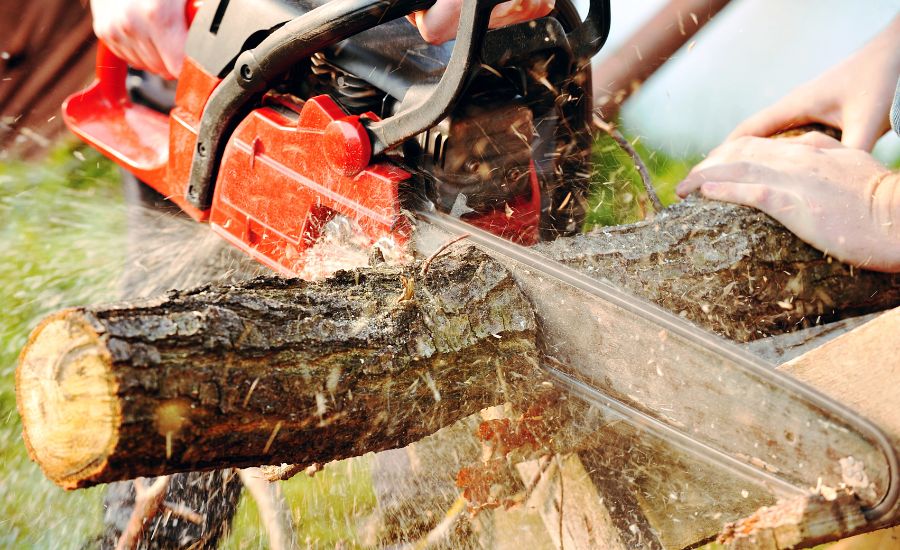Chainsaws, the mighty tools of arborists and lumberjacks, are the unsung heroes of the woodlands. However, behind their prowess in felling trees lies a symphony of noise that can be both deafening and potentially damaging to human hearing.
In this comprehensive exploration, we dive into the world of chainsaw noise, decibel levels, and the importance of ear protection.
How many decibels is a chainsaw and how loud is a chainsaw? What can be done to mitigate the auditory onslaught of these powerful machines? We embark on a unique journey to unravel the chainsaw’s sonic secrets.

Decoding the chainsaw’s roar
A chainsaw is much more than a mere tool; it’s a powerful instrument designed to cut through the toughest of wood, carving paths and shaping landscapes.
However, in the process of this rugged utility, chainsaws produce noise that is nothing short of impressive in its loudness.
The decibel (dB) measurement system is the yardstick we use to gauge the intensity of this noise.

How loud is a chainsaw?
To answer this question, we must first recognize that chainsaws come in various types, each with its unique decibel output:
Gas-powered chainsaws
Traditional gas chainsaw tools tend to have the most loud noises in the chainsaw family, producing an average noise level ranging from 90 dB to as high as 120 dB or more, depending on the make and model. The loud is a chainsaw if the engine and chains are big.
Electric chainsaws
Electric chainsaws, with their quieter electric motors, typically generate a noise level range between 70 dB and 100 dB, making them less ear-piercing than their gas-powered counterparts.
Battery-powered chainsaws
These modern marvels are the quietest among chainsaws, with an average sound level between 65 dB and 90 dB. They offer a more peaceful experience for the user and those in the vicinity.

The impact of chainsaw noise
Chainsaw noise is not merely a nuisance; it poses genuine risks to human hearing health. Excessive exposure to loud sounds, even for a brief duration, can cause hearing damage or loss, a condition that affects the delicate hearing nerve within the human ear.
The loud sound emitted by chainsaws, especially gas-powered ones, is well within the range that can inflict hearing damage over time.

Understanding decibels and human hearing
Before we delve deeper into chainsaw decibel noise levels and hearing protection, let’s take a moment to appreciate the intricacies of the decibel scale and how the human ears hear sounds.
The decibel scale
The decibel scale is logarithmic, meaning that each 10 dB increase represents a tenfold increase in sound intensity. For example, a sound at 90 dB is ten times more intense than a sound at 80 dB.
Human hearing
Human ears are remarkably sensitive to sound and capable of detecting an astonishing range of sound levels.
The outer ear captures the sound and sends it to the inner ear. In case of hearing loss, the ears stop being able to receive sounds.
On average, a normal conversation registers at about 60 dB, whereas a very loud rock concert may reach 120 dB.
The role of ear protection
Given the delicate nature of the human ear and the potential for hearing damage due to excessive noise exposure, wearing ear protection of the ear when operating or being near chainsaws is crucial for preserving hearing health.

Proper hearing protection in the chainsaw arena
When it comes to the noise of chainsaws, hearing protection isn’t a mere accessory; it’s a vital necessity. Here’s a closer look at the various types of hearing protection options available to shield your ears from the chainsaw’s roar:
Ear plugs
Ear plugs are small, discrete devices that fit snugly into the ear canal, providing an effective barrier against noise.
They are available in disposable foam or reusable silicone options, offering varying sound levels of noise reduction.
For chainsaw use, choosing a high Noise Reduction Rating (NRR) earplug is recommended.
Ear muffs
An ear muff, also known as an earmuff or ear defender, is designed to cover the entire ear, creating a seal to block out noise effectively.
They are easy to put on and remove, making them convenient for intermittent use during chainsaw work.
A combination of earplugs and earmuffs
For particularly loud environments, such as those where gas-powered chainsaw tools are in operation, using a combination of earplugs and ear muffs provides a dual layer of protection. This combination can achieve exceptional reduction of high noise levels.
The role of occupational safety
In many professional settings, particularly those involving forestry, arboriculture, or construction, regulations and guidelines emphasize the importance of protection of hearing for chainsaw operators.
Safety standards often mandate the use of specific hearing protectors to safeguard workers from noise-related hazards.

Chainsaw decibel levels and hearing protectors
To further understand the relationship between the decibel levels of a chainsaw and the protection of hearing, consider this analogy: you wouldn’t enter a construction zone without a hard hat, so why expose your ears to the cacophony of a chainsaw without proper hearing protection?
Here’s how to select the right hearing protector for the decibel level of your chainsaw:
- Gas-powered chainsaws (90 dB to 120+ dB): when dealing with the high decibel output of gas-powered chainsaw tools, it’s essential to opt for the most robust protection of hearing. This means earmuffs with a high NRR, typically rated above 25 dB. Using both earplugs and ear muffs, especially in extremely noisy environments, offers the best protection.
- Electric chainsaws (70 dB to 100 dB): electric chainsaws produce less noise than their gas-powered counterparts, but they still require protection of hearing. A good pair of earmuffs with an NRR in the range of 20–25 dB should suffice. Earplugs can be an alternative if they provide an adequate NRR.
- Battery-powered chainsaws (65 dB to 90 dB): a battery-powered chainsaw, being the quietest, demands less robust protection of hearing. Earmuffs with an NRR of 20 dB or high-NRR earplugs are generally sufficient for the protection of hearing in most situations.

FAQ
Here are presented some of the most commonly asked questions on the topic of this paper, with comprehensive answers to them.
How many decibels is an electric chainsaw?
An electric chainsaw typically produces a noise level range between 70 dB to 100 dB, depending on the model and power. They are generally quieter than gas-powered chainsaw tools.
What can 140 decibels do?
A sound at 140 chainsaw decibels causes extremely loud noise and immediate and permanent damage to hearing. Prolonged exposure to this level of noise can result in hearing loss and discomfort.
How many decibels is too loud?
Sounds above 85 dB are considered too loud and have the potential to damage hearing if exposed for extended periods. It’s crucial to wear ear protection when exposed to such levels of noise.
Can you get a quiet chainsaw?
Chainsaws powered by battery are generally quieter than gas-powered ones, with a noise level range averaging between 65 dB to 90 dB. They are a quieter and more environmentally friendly option.
What does 170 decibels do?
A sound at 170 chainsaw decibels is extremely intense and can cause physical harm, including damage to the human body and even death. Such levels of noise are associated with events like explosions and jet engine noise.
Conclusion
Chainsaws, the iconic tools of woodsmen and DIY enthusiasts alike, are marvels of engineering and power. Yet, the roar of a chainsaw can be deafening, potentially causing hearing damage and hearing loss over time. Knowing how many sound decibels a chainsaw produces is essential, as it informs us about the potential risks involved.
The use of appropriate protection of ears, such as earplugs and earmuffs, is paramount when operating or being near a chainsaw. Understanding the noise reduction ratings and matching them to the chainsaw’s decibel levels ensures effective protection of hearing.
As the world of chainsaws evolves, quieter and more efficient models continue to emerge, offering the promise of a quieter future. Until then, with the right hearing protection and a commitment to hearing health, we can continue to tame the auditory beast of the chainsaw while enjoying its remarkable capabilities safely and responsibly.


